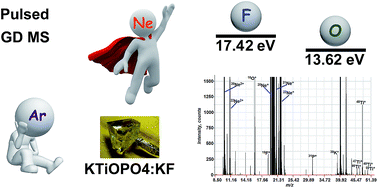Neon plasma for effective ionisation of oxygen and fluorine in pulsed glow discharge – high ionisation energy elements' quantification in potassium titanyl phosphate single crystals
Abstract
Neon glow discharge was tested for the direct analysis of solid dielectric materials by pulsed glow discharge time-of-flight mass spectrometry with an emphasis on the elements with high ionisation energy. The findings for neon were compared to conventional argon glow discharge. Fluorine doped potassium titanyl phosphate (KTP) single crystals were used for analysis. The following parameters were optimised: repelling pulse delay, discharge duration, and voltage and pressure in the discharge cell. Relative sensitivity factors were used for quantification; titanium was used for normalisation. Similar to argon glow discharge, the most effective mechanism for fluorine and oxygen ionisation was found to be attributed to high-energy electrons under short repelling pulse delays. Penning ionisation of oxygen in neon glow discharge was found to be less efficient. Overall, the use of neon significantly benefited fluorine and oxygen determination; the limits of detection for oxygen (0.0005 mass%) and fluorine (0.0002 mass%) decreased several times compared to argon glow discharge (0.001 and 0.01 mass%, respectively) as a result of more effective ionisation. The improvement was especially pronounced for fluorine, due to the alleviation of plasma-based interferences. However, for other KTP constituents – potassium, phosphorus and titanium – the analytical performance was expectedly lower, due to the lower sputtering rates in neon glow discharge. The limits of detection for potassium and phosphorus were significantly increased, being 0.008 mass% and 0.01 mass%, respectively. Notably, the performance for non-high ionisation energy elements was adequate for their single-run quantification along with oxygen and fluorine at non-trace levels. Thus, the use of neon as a discharge medium for pulsed glow discharge mass spectrometry is clearly justified for the determination of high ionisation energy elements such as oxygen and fluorine in non-conducting matrices.



 Please wait while we load your content...
Please wait while we load your content...